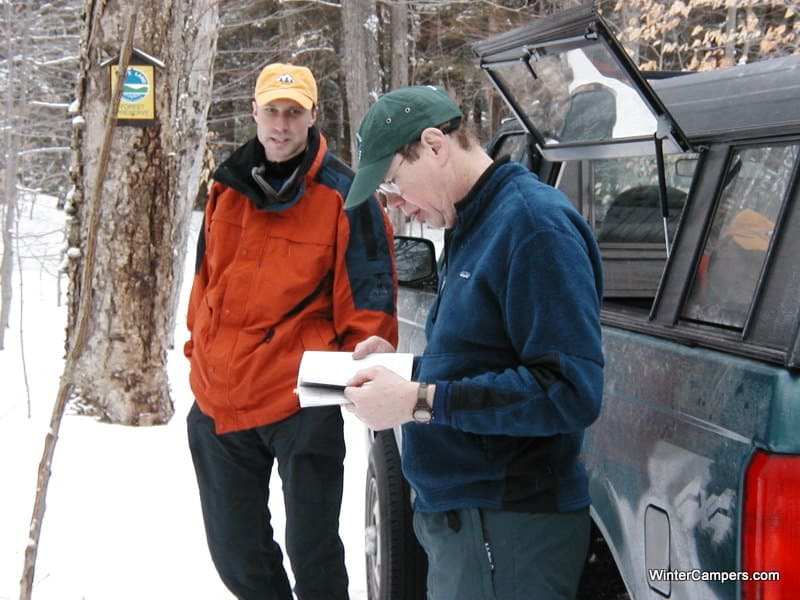
Poor planning often results in miserable campers and damage to natural and cultural resources. Trip planning is important as it:
- helps ensure the safety of groups and individuals.
- prepares you for Leave No Trace practices and minimizes resource damage.
- contributes to accomplishing trip goals safely and enjoyably.
- increases self-confidence and opportunities for learning more about nature.
Elements to consider when planning a trip
- Identify and record the goals (expectations) of your trip. Is this a ‘jamboree’ or are members of the group trying to accomplish specific goals such as reaching a specific destination.
- Identify the skill and ability of trip participants. Are there members of the group that are winter camping novices and if so, how will they be mentored?
- Select appropriate destinations that match your goals, skills, and abilities and plan trip activities to match your goals, skills, and abilities.
- Gain knowledge of the area you plan to visit from land managers, other hikers, maps, and literature. Use trail guides and the internet to perform as much research as possible prior to the trip.
- Choose your equipment and clothing for comfort and versatility.
- Know the weather forecast in advance
- Understand the terrain you will be traveling. Bring maps and photos along to help locate your journey on the terrain.
- Understand any regulations/restrictions that may apply, including parking.
- Understand and respect private land boundaries
- Anticipate the average hiking speed of group and likely food consumption Plan to accommodate the group size. Does it meet any specified land management regulations and fit your trip purpose?
- Evaluate your trip upon your return to note lessons learned and changes you will make next time.
You can prepare by:
- Educating yourself on the area you plan to visit. Learn about winter regulations, closures, and weather hazards. In upstate New York, where I live, the DEC Regulations[1], specifically the DEC State Land Use Regulations, regulate where to camp on State Land. Tents may be set up at designated sites which have yellow “Camp Here” markers discs with a black tipi, and your tent must be within 15 feet of this disc. Outside of designated sites, tents must be 150 feet from any trails or water. Lean-tos do not count as designated sites, so tents must be 150 feet from any lean-tos or trails leading to lean-tos as well. Designated sites will have a marker disc, so if there is a fire ring but not a disc, the campsite is not a legal one (unless it follows the 150 foot rule). Obviously, you can’t camp at any site that has a “No Camping” disc.
- Taking a winter back country course to gain experience.
- Expecting extreme weather and gear up for it.
- In mountainous country carrying an avalanche beacon, probe, and shovel.
- Planning a route appropriate for the experience level, size, and goals of your group. In the Adirondack Park one can contact the NYS DEC at (518) 897-1200 to determine trail conditions in the area you plan to visit. Adirondack Trail Information can also be found on the DEC web site[2].The web pages provide general information and seasonal conditions, specific notices on closures and other situations involving trails, roads, foot bridges, etc., and links to rules & regulations, hiker and camper safety, low impact recreation, weather and more.
- Leaving your excursion plans with two people, including your expected return time. They can begin a rescue if you do not return in reasonable time and will know where to start looking for you.
- Using a map and compass for navigation as trail markings may be hidden in snow and recognizing that batteries in GPS units may not work in cold temperatures.
- Realizing that night falls early. You will have much less time to travel and set up camp, so plan accordingly and understand that everything takes longer in cold weather.
- Ensuring you have appropriate gear for the worst-case environment. Use layering of clothes to keep warm and prevent overheating followed by freezing.
Follow our occasional Tweets @WinterCampers
________________________________________
[1] http://www.dec.ny.gov/regulations/regulations.html
[2] www.dec.ny.gov/outdoor/7865.html
SHARE
September 1st, 2011 | Category: Cold Weather Camping, Winter Camping, Winter Camping Skills
Comments are closed.

